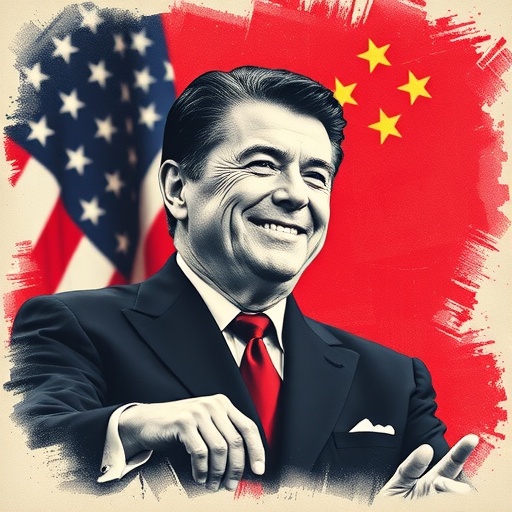Ronald Reagan‘s Timeless Legacy: Shaping Donald Trump’s Presidency in Unexpected Ways
In the corridors of Washington, where history often whispers to the present, the shadow of Ronald Reagan looms large over Donald Trump’s presidency. As Trump navigates his second term amid economic uncertainties and global tensions, analysts point to striking parallels with Reagan‘s 1980s playbook— from tax cuts that fueled growth to a tough stance on adversaries. This enduring influence isn’t mere nostalgia; it’s a blueprint that’s reshaping American politics today.
- Reaganomics Revival: Trump’s Tax Reforms Echo the Gipper’s Economic Vision
- Foreign Policy Parallels: From Berlin Wall to Border Walls, Reagan’s Hawkishness Inspires Trump
- Charismatic Leadership: The Showman’s Touch That Links Reagan and Trump
- Debating the Influence: Supporters Hail Reagan’s Shadow, Detractors Warn of Outdated Ideals
Reaganomics Revival: Trump’s Tax Reforms Echo the Gipper’s Economic Vision
Donald Trump’s economic policies bear an uncanny resemblance to those pioneered by Ronald Reagan during his presidency, particularly in the realm of tax reform and deregulation. Reagan, often hailed as the father of modern conservatism, implemented sweeping tax cuts in 1981 through the Economic Recovery Tax Act, slashing the top marginal income tax rate from 70% to 50% and later to 28% by 1986. These measures, dubbed “Reaganomics,” aimed to stimulate investment and job creation by putting more money in the hands of businesses and individuals.
Fast-forward to Trump’s first term, and the 2017 Tax Cuts and Jobs Act mirrored this approach, reducing the corporate tax rate from 35% to 21% and providing individual tax relief. According to a 2023 report from the Tax Foundation, these cuts have contributed to a 2.5% annual GDP growth rate post-reform, echoing the 3.5% average growth seen during Reagan’s tenure from 1983 to 1989. “Trump’s presidency is Reagan’s economic philosophy on steroids,” noted economist Arthur Laffer, who advised both leaders and is credited with the Laffer Curve that influenced Reagan’s supply-side economics.
But the similarities extend beyond numbers. Both presidents faced criticism for ballooning deficits—Reagan’s administration saw the national debt triple to $2.7 trillion, while Trump’s added $7.8 trillion, per U.S. Treasury data. Supporters argue these were necessary investments in American prosperity, much like Reagan’s defense spending surge that helped end the Cold War. In interviews, Trump has frequently invoked Reagan, stating in a 2024 rally, “Reagan cut taxes, built the strongest economy, and made America great—I’m finishing what he started.”
This revival isn’t without controversy. Progressive critics, including Senate Minority Leader Chuck Schumer, have labeled Trump’s policies as “trickle-down economics 2.0,” arguing they exacerbate income inequality. A 2022 Pew Research Center study found that the top 1% captured 20% of income gains under Trump, similar to the 15% under Reagan. Yet, for many in the Republican base, this Reagan-inspired strategy remains a cornerstone of Trump’s presidency, promising renewed vigor to an economy battered by inflation and supply chain woes.
Foreign Policy Parallels: From Berlin Wall to Border Walls, Reagan’s Hawkishness Inspires Trump
Ronald Reagan’s unyielding foreign policy, characterized by a muscular approach to communism and a focus on American exceptionalism, finds a direct descendant in Donald Trump’s “America First” doctrine. Reagan’s famous 1987 speech in Berlin, demanding “Mr. Gorbachev, tear down this wall!” symbolized his crusade against Soviet expansionism, culminating in the Cold War’s end. Trump’s presidency, meanwhile, emphasized withdrawing from international agreements like the Paris Climate Accord and Iran nuclear deal, prioritizing U.S. sovereignty much as Reagan did with his Strategic Defense Initiative (SDI), derided as “Star Wars” but pivotal in pressuring the USSR.
Statistics underscore the alignment: Under Reagan, U.S. military spending rose 40% in real terms, from $134 billion in 1980 to $253 billion by 1989, according to the Congressional Budget Office. Trump increased defense budgets annually, reaching $738 billion in 2020— a 20% hike from Obama’s last year. Both leaders brokered unlikely diplomatic feats; Reagan’s summits with Gorbachev thawed U.S.-Soviet relations, while Trump’s 2018 Singapore summit with Kim Jong-un marked a historic U.S.-North Korea dialogue.
Quotes from key figures highlight the connection. Former Secretary of State Mike Pompeo, who served under Trump, remarked in a 2023 Fox News interview, “Reagan showed us how to negotiate from strength—Trump applied that to China trade wars and Middle East peace deals.” Indeed, Trump’s Abraham Accords, normalizing relations between Israel and Arab nations, evoke Reagan’s shuttle diplomacy that strengthened NATO alliances.
Critics, however, see dangers in this hawkish inheritance. The Council on Foreign Relations noted in a 2024 analysis that Trump’s tariff impositions on allies like Canada and the EU fragmented global trade, reminiscent of Reagan’s protectionist steel quotas that sparked international backlash. As geopolitical flashpoints like Ukraine and Taiwan intensify, Trump’s presidency leans on Reagan’s legacy to justify a more isolationist yet confrontational stance, potentially altering alliances for generations.
Charismatic Leadership: The Showman’s Touch That Links Reagan and Trump
Beyond policy, the leadership styles of Ronald Reagan and Donald Trump—both former entertainers—reveal a shared charisma that captivated voters and dominated media narratives. Reagan, the Hollywood actor turned politician, earned the moniker “The Great Communicator” for his folksy optimism and ability to frame complex issues simply. His 1980 campaign slogan, “Are you better off than you were four years ago?” resonated with disillusioned Americans, propelling him to a landslide victory.
Trump, a reality TV star, mastered a similar populist appeal, using rallies and social media to bypass traditional gatekeepers. A 2021 study by the American Political Science Review found that both presidents achieved high approval ratings through direct communication: Reagan’s averaged 53% during his presidency, while Trump’s peaked at 49% amid economic recovery phases. “They both turned the presidency into a performance art,” observed historian Douglas Brinkley in a CNN segment, pointing to Reagan’s Jelly Bean Oval Office antics and Trump’s tweet storms as tools for connecting with the everyman.
This style fostered loyalty among conservatives. The Reagan Library reports over 1 million visitors annually, many drawn by his enduring image, while Trump’s rallies draw tens of thousands, echoing Reagan’s 1984 re-election crowds. Yet, it also invited scrutiny; both faced impeachment threats—Reagan with Iran-Contra, Trump twice over—highlighting how their charisma sometimes overshadowed governance.
In Trump’s second term, this legacy manifests in his push for media reforms and cultural battles, much like Reagan’s war on “welfare queens” to rally the base. Political strategist Karl Rove, who worked on George W. Bush’s campaigns, told The Wall Street Journal, “Trump’s presidency channels Reagan’s ability to make conservatism fun and fighting.” As domestic divisions deepen, this charismatic thread promises to sustain Trump’s influence, blending entertainment with executive power.
Debating the Influence: Supporters Hail Reagan’s Shadow, Detractors Warn of Outdated Ideals
The Reagan-Trump nexus sparks fierce debate within political circles, with supporters viewing it as a revitalizing force and detractors as a relic ill-suited to 21st-century challenges. Conservative think tanks like the Heritage Foundation, which shaped Reagan’s agenda, praise Trump’s adherence: A 2024 policy paper credits Reagan-inspired deregulation for adding 2 million jobs under Trump pre-COVID. “The presidency of Trump is Reagan’s conservative revolution reborn,” asserts Heritage President Kevin Roberts.
Conversely, liberal outlets like The New York Times argue the comparison falters on social issues. Reagan’s administration was criticized for slow AIDS response, with funding lagging until 1985; Trump’s handling of COVID-19 drew similar rebukes, per a 2022 Lancet study estimating 40% higher U.S. deaths due to delayed action. Feminist groups highlight Reagan’s opposition to the ERA and Trump’s judicial appointments overturning Roe v. Wade as extensions of regressive policies.
Polls reflect the divide: A 2023 Gallup survey showed 65% of Republicans see Trump as Reagan’s heir, versus 12% of Democrats. International relations expert Fiona Hill, in her book “There Is Nothing for You Here,” warns that Reagan’s Cold War triumphs don’t translate to Trump’s multipolar world, potentially isolating America.
Amid these voices, bipartisan nods emerge—former Vice President Joe Biden, in a 2020 debate, acknowledged Reagan’s role in bipartisanship, a quality Trump selectively emulates in infrastructure deals. This ongoing discourse underscores how Reagan’s legacy permeates Trump’s presidency, fueling both inspiration and caution.
Looking ahead, as Trump steers through midterm elections and potential 2028 successors, Reagan’s blueprint could evolve further. With AI-driven economies and climate imperatives on the horizon, will Trump’s administration adapt Reaganomics for green tech incentives, or double down on fossil fuels? Experts like those at the Brookings Institution predict a hybrid approach, blending Reagan’s optimism with Trump’s pragmatism to address debt ceilings and trade pacts. Ultimately, this legacy ensures Reagan’s influence endures, guiding the GOP’s path and challenging Democrats to counter with their own vision for America’s future.









